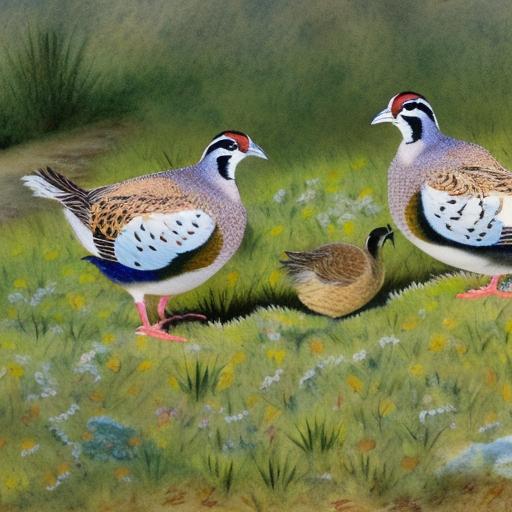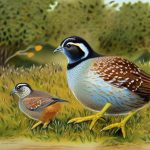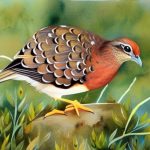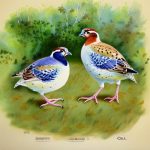The California quail, also known as the Valley quail, is a small ground-dwelling bird native to the western United States. They are known for their distinctive teardrop-shaped plume on their head, as well as their vibrant plumage and intricate feather patterns. These birds are highly social and often travel in large groups called coveys, which can consist of up to 200 individuals. California quail are primarily seed eaters, but they also consume insects and vegetation. They are commonly found in a variety of habitats, including grasslands, woodlands, and chaparral areas.
California quail are popular game birds and are often hunted for sport. However, they are also valued for their beauty and are frequently kept as pets or for ornamental purposes. Their distinctive appearance and pleasant call make them a favorite among birdwatchers and nature enthusiasts. These birds are known for their adaptability and resilience, and they have successfully established populations in urban and suburban areas. Despite their widespread distribution, California quail face numerous threats to their survival, including habitat loss, predation, and climate change.
Key Takeaways
- California quail are small, ground-dwelling birds native to the western United States.
- They reach sexual maturity and breeding age at around 3-4 months old.
- Factors such as food availability, weather, and habitat quality can affect the breeding age of California quail.
- Breeding season for California quail typically occurs in the spring and involves elaborate courtship displays.
- Breeding age is crucial for the population dynamics and sustainability of California quail in the wild.
- In captivity, California quail can breed at a younger age due to controlled environments and abundant food supply.
- Conservation efforts for California quail focus on preserving and restoring their natural habitats, as well as managing hunting and predation pressures.
Sexual Maturity and Breeding Age
California quail reach sexual maturity at around 3-4 months of age, at which point they are able to breed and produce offspring. However, the ideal breeding age for these birds is typically around 6-8 months. This allows the birds to reach their full adult size and develop the necessary physical and behavioral traits for successful reproduction. Female quail are capable of laying eggs as early as 6-8 months old, while males are able to fertilize eggs at a similar age.
Breeding age is an important factor in the reproductive success of California quail. Birds that breed too early may not have fully developed reproductive organs or may lack the necessary experience to care for their offspring. On the other hand, delaying breeding too long can result in decreased fertility and overall reproductive success. Finding the optimal breeding age is crucial for maintaining healthy populations of California quail.
Factors Affecting Breeding Age
Several factors can influence the breeding age of California quail. One of the most significant factors is environmental conditions, particularly food availability and habitat quality. Birds that have access to abundant food resources and suitable nesting sites may reach sexual maturity at an earlier age than those living in less favorable conditions. Additionally, social dynamics within a covey can also impact breeding age, as dominant individuals may have greater access to resources and mating opportunities.
Genetics also play a role in determining breeding age, as certain individuals may mature more quickly or slowly than others due to their genetic makeup. Health and overall condition can also affect breeding age, as birds that are in poor physical condition may delay breeding until they are able to recover and regain their strength. Finally, external factors such as predation pressure and climate can influence breeding age, as birds may delay reproduction in response to increased threats or unfavorable weather conditions.
Breeding Season and Behavior
The breeding season for California quail typically begins in late winter or early spring and extends into the summer months. During this time, male quail engage in elaborate courtship displays to attract females. These displays often involve puffing out their chest feathers, calling loudly, and performing intricate dances. Once a pair has formed, the male will continue to display for the female to maintain her interest.
Nesting behavior in California quail is also quite fascinating. The female selects a well-hidden nest site on the ground, often in dense vegetation or under shrubs. She constructs a shallow depression in the soil and lines it with grasses and other plant material. The female then lays a clutch of 12-16 eggs, which she incubates for about 21 days. Once the chicks hatch, they are precocial and able to leave the nest within hours of hatching. The male plays an active role in protecting the nesting female and caring for the chicks once they hatch.
Importance of Breeding Age for California Quail Population
The breeding age of California quail is crucial for maintaining healthy populations of these birds. Breeding too early or too late can have significant impacts on reproductive success and overall population dynamics. Birds that breed too early may produce smaller clutches or have lower hatch rates due to their immature reproductive systems. Additionally, young birds may lack the experience and skills necessary to successfully raise their offspring, leading to higher rates of chick mortality.
On the other hand, delaying breeding too long can result in decreased fertility and overall reproductive success. Older birds may experience reduced egg quality and lower hatching success, leading to fewer offspring being produced. Finding the optimal breeding age is essential for ensuring that California quail populations remain stable and sustainable over time.
Breeding Age in Captivity
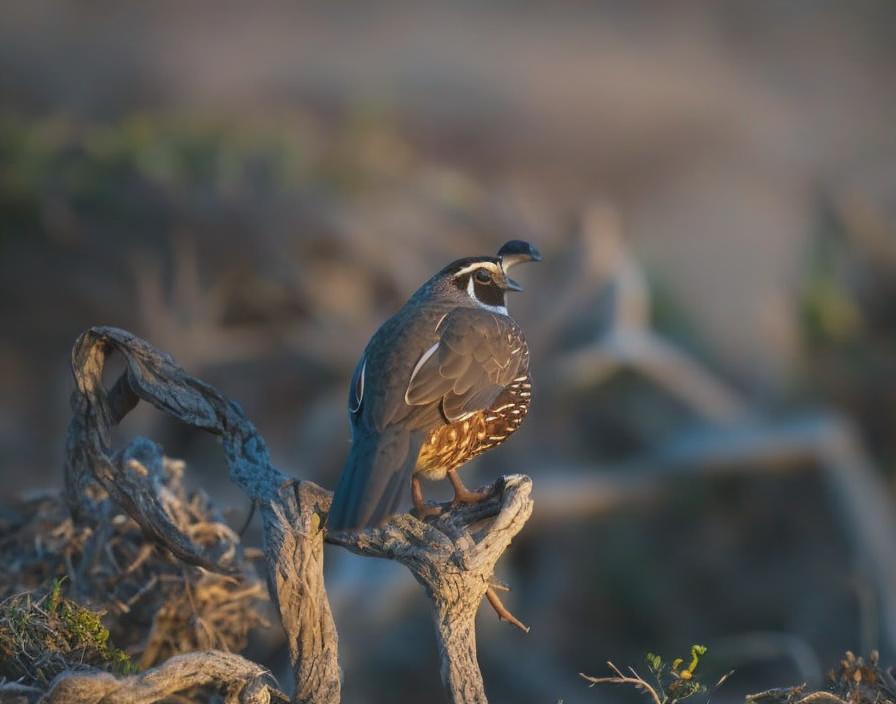
In captivity, California quail breeding age can be influenced by a variety of factors related to husbandry practices and environmental conditions. Birds that are provided with high-quality nutrition and ample space to exercise may reach sexual maturity at an earlier age than those kept in suboptimal conditions. Additionally, the presence of suitable nesting sites and appropriate social dynamics within a captive group can also impact breeding age.
Breeding age in captivity can also be influenced by genetic factors, as certain individuals may mature more quickly or slowly than others due to their genetic makeup. Selective breeding programs can be used to promote early sexual maturity and other desirable traits in captive populations of California quail. By carefully managing breeding age and other reproductive parameters, captive populations can be maintained in a healthy and sustainable manner.
Conservation Efforts for California Quail
Conservation efforts for California quail focus on addressing the various threats facing these birds, including habitat loss, predation, and climate change. Habitat restoration projects aim to create and maintain suitable nesting and foraging areas for quail populations. This may involve planting native vegetation, controlling invasive species, and implementing land management practices that benefit quail habitat.
Predation management is another important aspect of conservation efforts for California quail. By reducing predation pressure from introduced species such as feral cats and foxes, conservationists can help improve nesting success and overall survival rates for quail populations. Climate change poses a significant threat to California quail, as rising temperatures and altered precipitation patterns can impact food availability and nesting success.
In addition to these efforts, public education and outreach programs aim to raise awareness about the importance of conserving California quail and their habitats. By engaging local communities and stakeholders in conservation initiatives, efforts to protect these iconic birds can be more effective and sustainable in the long term. Overall, conservation efforts for California quail are essential for ensuring that these birds continue to thrive in their natural habitats for generations to come.
If you’re interested in learning more about the breeding age of California quails, you might also find our article on “How Big Does a Coop Need to Be for a Chicken?” helpful. Understanding the space requirements for chickens can provide valuable insights into creating suitable breeding environments for quails as well. Check out the article here.
FAQs
What is the breeding age of California quail?
The breeding age of California quail is typically around 6-9 months old.
At what time of year do California quail breed?
California quail typically breed in the spring and early summer months.
How many eggs do California quail lay?
A female California quail can lay anywhere from 12-16 eggs in a single clutch.
How long does it take for California quail eggs to hatch?
It takes approximately 21 days for California quail eggs to hatch after they have been laid.
At what age do California quail chicks leave the nest?
California quail chicks are precocial and will leave the nest shortly after hatching, usually within a few hours.
How long does it take for California quail chicks to reach maturity?
California quail chicks reach maturity at around 3-4 months of age.
Meet Walter, the feathered-friend fanatic of Florida! Nestled in the sunshine state, Walter struts through life with his feathered companions, clucking his way to happiness. With a coop that’s fancier than a five-star hotel, he’s the Don Juan of the chicken world. When he’s not teaching his hens to do the cha-cha, you’ll find him in a heated debate with his prized rooster, Sir Clucks-a-Lot. Walter’s poultry passion is no yolk; he’s the sunny-side-up guy you never knew you needed in your flock of friends!

